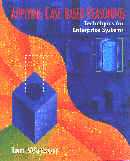 |
Applying Case-Based Reasoning: Techniques for Enterprise
Systems
by Ian Watson
Paperback, 250 pages
Published by Morgan Kaufman Publishers
Publication date: July 1, 1997
ISBN: 1558604626 |

Case-based reasoning (CBR) is an intelligent-systems
method that enables information managers to increase efficiency and reduce cost by
substantially automating processes such as diagnosis, scheduling and design. A case-based
reasoner works by matching new problems to "cases" from a historical database
and then adapting successful solutions from the past to current situations. Organizations
as diverse as IBM, VISA International, Volkswagen, British Airways, and NASA have already
made use of CBR in applications such as customer support, quality assurance, aircraft
maintenance, process planning, and decision support, and many more applications are easily
imaginable. It is relatively simple to add CBR components to existing information systems,
as this book demonstrates. The author explains the principles of CBR by describing its
origins and contrasting it with familiar information disciplines such as traditional data
processing, logic programming, rule-based expert systems, and object-oriented programming.
Through case studies and step-by-step examples, he goes on to show how to design and
implement a reliable, robust CBR system in a real-world environment. Additional resources
are provided in a survey of commercially available CBR tools, a comprehensive
bibliography, and a listing of companies providing CBR software and services.

Chapter 1: What Is Case-Based Reasoning?
Chapter 2: Understanding CBR
Chapter 3: The Application of CBR
Chapter 4: Industrial Applications of CBR
Chapter 5: CBR and Customer Service
Chapter 6: CBR Software Tools
Chapter 7: Building a Diagnostic Case-Base
Chapter 8: Building, Testing, and Maintaining Case-Bases
Chapter 9: Conclusion
Chapter 10: Bibliography (over 600 CBR references in easy to use categories)

Computer
Programming Editor's Recommended Book,
01/01/98
Case-based reasoning (CBR) is one of the most promising recent technologies for building
intelligence into computers. This useful introduction to the technology shows what CBR is,
why it is important, and how it can be applied to some intriguing real-world problems. The
early part of this text outlines the the so-called four "re-'s" of CBR:
retrieve, reuse, revise, and retain. Basically, CBR systems match possible solutions to a
database of earlier questions, retrieve the answer, and adapt (or revise) it. If
appropriate, CBR systems can even save (or retain) these new problems and solutions to its
"case-base" for later reuse. For example, if your car does not start, you can
use a CBR to match the characteristics of your problem with a database of diagnoses.
The author does a fine job of distinguishing CBR from
other artificial intelligence models, such as expert systems (which are rules-based and
can be hard to develop because experts don't always get their expertise translated
perfectly by programmers) and neural networks (CBR can be more accurate because it can
match characteristics and give a reason, while a neural network cannot), and proving that
CBR can be faster computationally. He also gives an excellent presentation on how CBR has
been used successfully in a surprising range of applications, such as manufacturing,
medicine, law, and help desk systems for products, including Web-based applications
systems for users. (Help desk applications are a natural fit for CBR technology, but they
are not its only use.)
CBR has already enjoyed considerable success without
many people knowing about it. (As the author suggests, expert systems, a promising older
artificial intelligence [AI] technology, never quite lived up to its initial dazzle.) The
author shows that CBR research has already been used to create products. He provides a
survey of tools from two continents as well as an extensive bibliography for those experts
who want to read more on the subject.

|